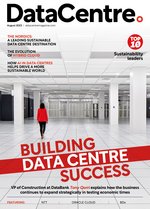
Businesses are moving to the cloud faster than ever before with spending on cloud computing accounting for 33% of IT spend in 2020 and growing to 45% by 2024, according to Gartner. For many, adopting a cloud model is compelling compared to owning and operating on-premises data centres.
With advantages including lower costs, increased agility, and faster innovation, the cloud accelerates digital transformation as it provides access to hundreds of tools and capabilities only possible with the breadth of services and scale of the cloud.
To support this shift, AWS’ Gareth Tucker explains, businesses need to be able to seamlessly operate a broad range of applications — from Software-as-a-Service web applications to applications that process real-time medical imaging.
“Most of these applications can be easily migrated to the cloud, but some need to be re-architected or ‘modernised’ before they can be moved, and a few will remain on premises or in a specific location due to low latency, local data processing, or data residency requirements,” he says.
“Regardless of where their applications may need to reside, businesses today want to bring the cloud closer to wherever they need it to build and run their applications.”
The evolution of hybrid cloud
The definition of hybrid infrastructure itself is evolving rapidly, now encompassing a combination of cloud services, edge nodes, and on-premises data centres. At AWS, hybrid infrastructure is considered to include the cloud along with other edge nodes, on-premises data centres being one of them.
“Adopting a hybrid cloud infrastructure allows organisations to more effectively meet their business needs, using cloud services where they are needed - in their own facilities, at the mobile edge or in a remote branch or location,” he says.
“A key benefit is accelerating digital transformation and innovation. Being able to deploy new generation applications regardless of physical location brings greater flexibility, reduces time and effort for development teams and enables applications to be deployed where they are needed.”
Another benefit is improving IT productivity. By harmonising the management of all their IT facilities, IT teams gain significant benefit from using a single management platform, common tools, services, and APIs. “Using AWS, a common set of administration tools, services and processes can be used by all staff regardless of where resources are deployed,” Tucker alludes. “This avoids the need to operate different management platforms depending on what and where services are running, saving time, resources, and having to maintain knowledge and skills across different environments.”
Hybrid cloud infrastructures also allow IT teams to build differentiated services and improve end user experience. Extending the cloud and deploying applications to edge locations can dramatically improve services that are latency dependent. Latency can play a massive part in affecting the user experience, especially for applications involving interactivity including AR/VR, gaming, connected vehicles, smart factories and live video streaming.
Industries experiencing the hybrid cloud boom
AWS sees customers of all sizes leveraging AWS hybrid services, and is looking to create more industry-aligned solutions based on customer needs.
“Some of our AWS Local Zones have had their services tailored for specific industries such as in Los Angeles, where the AWS Local Zone has services to better suit the needs of the Media and Entertainment industry to provide digital artists at customers like Netflix high powered graphical workstations with latencies as low as 1-2ms, making the experience hard to distinguish from being on-premises,” Tucker uses as an example.
“Customers have come to really appreciate that the AWS culture is really different. We are reinventing hybrid cloud by bringing AWS wherever customers need it for seamless and secure experiences—from the cloud, to data centres, large metro areas and 5G networks, smart factories or buildings, and beyond.”
Hybrid cloud’s work towards sustainability and efficiency goals
AWS, like other hybrid cloud providers, is committed to running its business in an efficient way to reduce its impact on the environment. Its scale allows AWS to achieve higher resource utilisation and energy efficiency than the typical on-premises data centre. Studies conducted by analyst firm 451 Research found across several geographic regions that moving on-premises workloads to AWS can lower the workload carbon footprint by nearly 80% and up to 96% once AWS is powered with 100% renewable energy, by 2025.
AWS’ infrastructure is 3.6 times more energy efficient than the median of surveyed US enterprise data centres and up to five times more energy efficient than the average European enterprise data centre. Once all of Amazon’s renewable energy projects are fully operational, they are expected to provide enough clean energy to power 15.3 million European homes a year.
Tucker explains how for AWS, running our operations sustainably means reducing the amount of water used to cool its data centres. “AWS will be water positive by 2030, returning more water to communities than it uses in its direct operations. Our holistic approach minimises both energy and water consumption in our data centre operations and guides the development of our water use strategy for each AWS Region.
“AWS is continually improving efficiency, using advanced cloud services, such as IoT technologies, to analyse real-time water use, identify and fix leaks, and gain other efficiencies. AWS is also improving operational efficiency by using techniques like direct evaporative cooling and eliminating cooling water use in many facilities for most of the year, instead of relying on outside air.”
Additionally, in Ireland and Sweden, no water is used to cool its data centres for 95% of the year. AWS is also investing in on-site water-treatment systems to reuse water multiple times, minimising water consumption.
“We focus on efficiency across all aspects of our infrastructure, from the design of our data centres and hardware to modelling the performance of our operations for continually enhanced efficiency,” he adds. “One way our customers are able to move toward meeting their sustainability goals is by migrating to AWS. Amazon is committed to reaching net-zero carbon across our business by 2040, staying on path to power our operations with 100% renewable energy by 2025, and being water positive by 2030.”
AWS is further lowering its carbon emissions throughout its operations by focusing energy efficiency and addressing a broad category of indirect emissions, including those associated with the construction of our data centres.
“Once our customers migrate to AWS, we help customers improve their sustainability in the cloud through tools such as the Sustainability Pillar for Well-Architected and the customer carbon footprint tool. We help our customers understand the environmental impacts of the services they use, we quantify impacts through their entire workload lifecycle, and apply best practices to reduce these impacts.”







